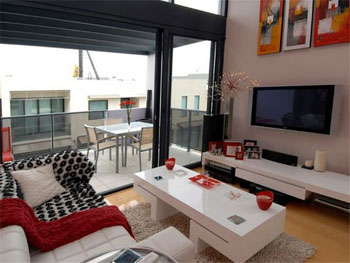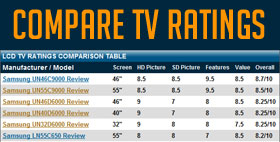Step 4: Flat Screen LCD and LED LCD TV screen size considerations; Which size is right for you?
By Robert Wiley, Senior Editor
Determine the right screen size based on your budget and your floor plan.
 In the past, flat screen LCD TVs were more common in smaller sizes (27" and less) and LED backlit LCD TVs were produced in the largest sizes. One reason was that quality-control issues limited display size: Increasing the size of an LCD panel meant adding pixels and three transistors for each additional pixel. It also made distributing the light evenly more difficult, which, in turn, interfered with color reproduction. This is why colors sometimes appeared slightly off or faded in larger LCD TVs. Modern production techniques and LED backlighting technology have eliminated this problem in current large LCD screens.
In the past, flat screen LCD TVs were more common in smaller sizes (27" and less) and LED backlit LCD TVs were produced in the largest sizes. One reason was that quality-control issues limited display size: Increasing the size of an LCD panel meant adding pixels and three transistors for each additional pixel. It also made distributing the light evenly more difficult, which, in turn, interfered with color reproduction. This is why colors sometimes appeared slightly off or faded in larger LCD TVs. Modern production techniques and LED backlighting technology have eliminated this problem in current large LCD screens.
Now factories in Japan and Korea can mass-produce the super sized sheets of glass embedded with transistors that are necessary to achieve large-scale LCDs. All of which means you'll be seeing larger flat-screen LCD displays with increasingly smaller price tags. LCD prices have been falling rapidly lately, nearly inline with plasma but with screens 50 inches and larger you will still find the most value for the dollar in a plasma television. So, if you're choosing purely based on flat-panel display size, Plasma is still the better choice but in another year or two prices may equalize between the two technologies or LCD panels may even be less expensive.
To get the most out of your investment, remember what your mother always said about sitting too close to the TV-that it's no good for you. Well, she might have been thinking about your health, but we're thinking about your viewing pleasure. For the optimal viewing experience, you need to maintain the right distance between your viewing area and your television screen.
Note: Some audio-visual critics have observed that fixed-pixel displays tend to show their pixel structures at closer viewing distances, so one might notice a sandy texture to the screen when the set is viewed too close. This underscores the importance of maintaining an appropriate viewing distance between you and your LCD or LED TV when configuring your viewing area.
The right distance depends on the size of your Flat Sreen LCD or LED LCD:
- For 20 to 27-inch displays, you should be able to watch comfortably from 2.5 to 5 feet away.
- For 32 to 37-inch TVs, you should sit back 6 to 8 feet from the screen itself.
- For 42 to 46-inch TVs, you'll need 10 to 13 feet between you and the screen.
- 50-inch LCD or LED TVs displays look best when viewed from 12 to 16 feet away.
- 60-inch LED LCD TVs are best viewed from 14 to 16 or more.
- 70-inch LED LCD TVs. You should sit 16 to 20 feet or more from the TV.
Get the lowdown on HDTV compatibility.
If you're one of the 55+ million households sitting astride cable systems that can carry HDTV signals, your LCD or LED LCD TV will enable you to take advantage of the better picture you can get from a higher resolution unit displaying digital HDTV broadcasts. Most LCD Televisions come with built-in ATSC tuners, which enable them to pick up over-air HD broadcasts using antennas. In addition, manufacturers have begun packaging ATSC and cable tuners in LCD TV sets, making them optimal for watching digital HDTV-on local as well as national broadcasts.
8 steps to buying an LCD TV
- Step 1: What exactly is LCD TV?
- Step 2: How do LCD Televisions work?
- Step 3: What are the advantages of LCD Televisions?
- Step 4: What do you need to consider before you buy your LCD TV?
- Step 5: Installation Considerations
- Step 6: View the Top 10 LCD Televisions
- Step 7: How and Where to buy a LCD TV
- Step 8: Find reputable online LCD Televisions Dealers









